စီချွမ်
စီချွမ် ( 四川 ; ရောမအက္ခရာဖြင့် ဆီချွမ်းသို့မဟုတ် Szechwan ဟု ရေးပါသည်) ကုန်းတွင်းပိတ် ပြည်နယ်တစ်ခုဖြစ်ပြီး တရုတ်ပြည် အနောက်တောင်ပိုင်းတွင်တည်ရှိပြီး စီချွမ်ကမ်းရိုးတန်းနှင့် တိဘက်ကုန်းပြင်မြင့် အရှေ့ဘက်ကျသည့်နေရာများ နှင့် အနောက်ဘက် ကျင်းရှာမြစ်တို့ ကြား၊, သာပါ တောင်တန်း မြောက်ဘက်အထိ၊ ယွမ်ကွေ့ကုန်းပြင်မြင့် တောင်ဘက်အထိ ကျယ်ပြန့်စွာ နေရာယူထားပါသည်။ စီချွမ်ပြည်နယ်၏ မြို့တော်မှာ ချန်ဒူး ဖြစ်သည်။ စီချွမ်ပြည်နယ်၏ လူဦးရေမှာ ၈၁ သန်းရှိပါသည်။
စီချွမ်သည်ဟန်မင်းဆက်မှဆင်းသက်သောဘုရင်များ၏ကိုယ်ပိုင်အုပ်ချုပ်ခွင့်ရအုပ်ချုပ်မှုအောက်တွင်ရှိသည်။ ဒုတိယရာစုတွင် ဟန်မင်းဆက် ၏အုပ်ချုပ်မှုယိုယွင်းလာသည့်နောက်တွင်စီချွမ်မြစ်ဝှမ်းသည်တောင်တန်းများနှင့်ဝိုင်းရံထားကာအလွယ်တကူကာကွယ်နိုင်သည့်အရာဖြစ်လာသည်။ စစ်ဗိုလ်ချုပ်များသည်တရုတ်နိုင်ငံအပေါ်ယန်ဇီချိုင့် ဧကရာဇ်မင်း၏အာဏာကိုစိန်ခေါ်ခဲ့သည်။ [1]
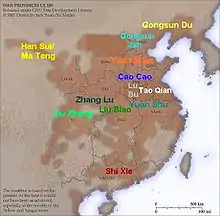
၂၆၃ တွင်မြောက်တရုတ်နိုင်ငံ၏ ကျင်မင်းဆက် သည် ရှူ-ဟန်ကိုတိုင်းပြည်ကို သိမ်းပိုက်ပြီး တရုတ်နှင့်ပြန်လည်ပေါင်းစည်းရန်လမ်းခရီး၌ပထမအဆင့်ဖြစ်သည်။ ဆားထုတ်လုပ်မှု သည် Ziliujing ခရိုင် တွင်အဓိကစီးပွားရေးလုပ်ငန်းတစ်ခုဖြစ်လာသည်။ ဒီကာလအတွင်း ခြောက်မင်းဆက် တရုတ်ညီညွတ်မှုတိုးများကာလ, စီချွမ်မဟုတ်သောဖြင့်လူနေထူထပ်ခံရဖို့စတင်ခဲ့ ဟန် ၏ရွှေ့ပြောင်းဖို့မရှိစေရန်, တိုင်းရင်းသားလူနည်းစုလူမျိုး Gelao လူတွေ မှ ယူနန်ပြည်နယ်-Guizhou Plateau ဟန်ဌာနေတိုင်းရင်းသားများဖြစ်ကြသည်ရှိရာစီချွမ်အင်တုံ, ရန်။
တန်မင်းဆက်

| စီချွမ်ဒေသ | |||||||||||
|---|---|---|---|---|---|---|---|---|---|---|---|
| ဒေသဆိုင်ရာ ကုဒ်နံပါတ် | ဒေသ | ဧရိယာ km2 | လူဦးရေ 2010 | တံဆိပ် | ဒေသများ | ||||||
| ခရိုင် | မြို့နယ် | Aut. counties | CL cities | ||||||||
| 510000 | စီချွမ်ပြည်နယ် | 485,000.00 | 80,418,200 | ချင်းဒူ မြို့ | 54 | 107 | 4 | 18 | |||
| 510100 | ချင်းဒူ မြို့ | 12,163.16 | 14,047,625 | ဝူဟုံ
ခရိုင် |
11 | 4 | 5 | ||||
| 510300 | ဇီကုင်မြို့ | 4,373.13 | 2,678,898 | ဇိလျူကျင်
ခရိုင် |
4 | 2 | |||||
| 510400 | ဖန်ကျိဟွာမြို့ | 7,423.42 | 1,214,121 | သုင်း
ခရိုင် |
3 | 2 | |||||
| 510500 | လူကျုင်မြို့ | 12,233.58 | 4,218,426 | ကျန်းယန် ခရိုင် | 3 | 4 | |||||
| 510600 | ဒေအ်ယန်မြို့ | 5,951.55 | 3,615,759 | ကျန်းယန်ခရိုင် | 2 | 1 | 3 | ||||
| 510700 | မြန်ယန်မြို့ | 20,267.46 | 4,613,862 | ဖှူချန်
ခရိုင် |
3 | 4 | 1 | 1 | |||
| 510800 | ကွမ်ယွင့်မြို့ | 16,313.70 | 2,484,125 | လီကျိုဝ်
ခရိုင် |
3 | 4 | |||||
| 510900 | စွေ့နင် မြို့ | 5,323.85 | 3,252,551 | ချွမ်ရှန် ခရိုင် | 2 | 2 | 1 | ||||
| 511000 | နေ့ကျန်မြို့ | 5,385.33 | 3,702,847 | ရှီကျုင်
ခရိုင် |
2 | 2 | 1 | ||||
| 511100 | လေအ်ရှန်မြို့ | 12,827.49 | 3,235,756 | ရှီကျုင်
ခရိုင် |
4 | 4 | 2 | 1 | |||
| 511300 | နန်ချုင်မြို့ | 12,479.96 | 6,278,622 | ရွှင့်ချင် ခရိုင် | 3 | 5 | 1 | ||||
| 511400 | မေ့ရှန်မြို့ | 7,173.82 | 2,950,548 | ဒုင်ဖော် ခရိုင် | 2 | 4 | |||||
| 511500 | ယီပင်မြို့ | 13,293.89 | 4,472,001 | စွေ့ဖင်
ခရိုင် |
3 | 7 | |||||
| 511600 | ကွမ်အန်မြို့ | 6,301.41 | 3,205,476 | ကွမ်အန် ခရိုင် | 2 | 3 | 1 | ||||
| 511700 | သာကျုင်မြို့ | 16,591.00 | 5,468,092 | ထုင်ချွမ် ခရိုင် | 2 | 4 | 1 | ||||
| 511800 | ယာအန်မြို့ | 15,213.28 | 1,507,264 | ယုချဲန် ခရိုင် | 2 | 6 | |||||
| 511900 | ပါးကျုင်မြို့ | 12,301.26 | 3,283,771 | ပါးကျုင် ခရိုင် | 2 | 3 | |||||
| 512000 | ဇီုယန်မြို့ | 7,962.56 | 3,665,064 | ယန်ကျန် ခရိုင် | 1 | 2 | |||||
| 513200 | ငါဝတိဘတ်ကိုယ်ပိုင်အုပ်ချုပ်ခွင့်ရစီရင်စု | 82,383.32 | 898,713 | Barkam city | 12 | 1 | |||||
| 513300 | ဂါဇိအ်
တိဘတ် ကိုယ်ပိုင်အုပ်ချုပ်ခွင့်ရစီရင်စု |
147,681.37 | 1,091,872 | Kangding city | 17 | 1 | |||||
| 513400 | လျန်ရှန် ယီ ကိုယ်ပိုင်အုပ်ချုပ်ခွင့်ရစီရင်စု | 60,422.67 | 4,532,809 | Xichang city | 15 | 1 | 1 | ||||
Sub-provincial cities | |||||||||||
| တရုတ်အုပ်ချုပ်ရေးကွဲပြားမှုနှင့် romanizations ၏မျိုးကွဲ | ||||
|---|---|---|---|---|
| အင်္ဂလိပ် | တရုတ် | Pinyin | စီခြှမျး Romanzation | |
| စီချွမ်ပြည်နယ် | 四川省 | SìchuānShěng | si4 cuan1 sen3 | |
| ချင်းဒူ မြို့ | 成都市 | ChéngdūShì | cen2 du1 si4 | |
| ဇီကုင်မြို့ | 自贡市 | ZìgòngShì | ||
| ဖန်ကျိဟွာ မြို့ | 攀枝花市 | PānzhīhuāShì | ||
| လူကျုင် မြို့ | 泸州市 | LúzhōuShì | nu2 zou1 si4 | |
| ဒေး မြို့ | 德阳市 | DéyángShì | ||
| Mianyang city | 绵阳市 | MiányángShì | ||
| Guangyuan မြို့ | 广元市 | GuǎngyuánShì | ||
| Suining city | 遂宁市 | SùiníngShì | xu4 nin2 si4 | |
| Neijiang မြို့ | 内江市 | NèijiāngShì | nui4 jiang1 si4 | |
| လီရှန် မြို့ | 乐山市 | LèshānShì | ||
| နန်ချောင်း မြို့ | 南充市 | NánchōngShì | si2 cong1 lan2 | |
| မိုင်ရှန် မြို့ | 眉山市 | MéishānShì | mi2 san1 si4 | |
| Yibin မြို့ | 宜宾市 | YíbīnShì | ni2 bin1 si4 | |
| Guang'an မြို့ | 广安市 | Guǎng'ānShì | ||
| Dazhou မြို့ | 达州市 | DázhōuShì | ||
| Ya'an မြို့ | 雅安市 | Yì'ānShì | ||
| Bazhong မြို့ | 巴中市 | BāzhōngShì | ||
| ဇီယန် မြို့ | 资阳市 | ZīyángShì | ||
| Ngawa တိဘက်နှင့် Qiang ကိုယ်ပိုင်အုပ်ချုပ်ခွင့်ရစီရင်စု | 阿坝藏族羌族自治州 | အာဘZangzúQiāngzúZìzhìzhōu | ||
| Garzêတိဘက်ကိုယ်ပိုင်အုပ်ချုပ်ခွင့်ရစီရင်စု | 甘孜藏族自治州 | GānzīZangzúZìzhìzhōu | ||
| Liangshan ရီကိုယ်ပိုင်အုပ်ချုပ်ခွင့်ရစီရင်စု | 凉山彝族自治州 | LiángshānYízúZìzhìzhōu | ||
ဘာသာတရား
- Religious sites in Sichuan
 Huanglongရှိနဂါး ဝါဝါ ဘုရားကျောင်း (တရုတ်ဗုဒ္ဓဘာသာ) ၏အမြင်
Huanglongရှိနဂါး ဝါဝါ ဘုရားကျောင်း (တရုတ်ဗုဒ္ဓဘာသာ) ၏အမြင်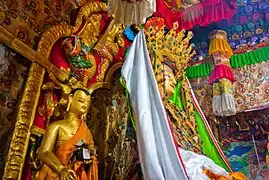 တိဘက်အစဉ်အလာ၏ လိထန်ဘုန်းကြီးကျောင်းရှိ ဗုဒ္ဓရုပ်ပွားတော်။
တိဘက်အစဉ်အလာ၏ လိထန်ဘုန်းကြီးကျောင်းရှိ ဗုဒ္ဓရုပ်ပွားတော်။ Chengdu, ချင်ချန်ရှန်ရှိ ရှန်ကျင်ဘုရားကျောင်း (Taoist) ၏ပြခန်းတစ်ခု။
Chengdu, ချင်ချန်ရှန်ရှိ ရှန်ကျင်ဘုရားကျောင်း (Taoist) ၏ပြခန်းတစ်ခု။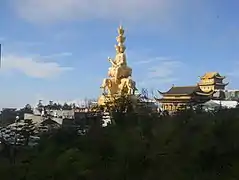 Emei တောင်တန်း ၏ဘုရားကျောင်း (တရုတ်ဗုဒ္ဓဘာသာ) ။
Emei တောင်တန်း ၏ဘုရားကျောင်း (တရုတ်ဗုဒ္ဓဘာသာ) ။
ကိုးကွယ်ယုံကြည်မှု စုံလင်ပြီး ရိုးရာကို ကိုးကွယ်ကြသည်။
ဘာသာစကားများ
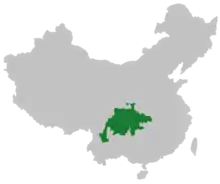
စီချွမ်ပြည်နယ်ရှိ ဘာသာစကားများသည်အဓိကအားဖြင့် တရုတ် - တိဘက်ဘာသာစကားသုံးမျိုး၏မိသားစုဝင်များဖြစ်သည်။
စီချွမ်အတွက်ပြောပြီတရုတ်အရှိဆုံးအသုံးများအမျိုးမျိုးဖြစ်ပါတယ် Sichuanese အဘိဓာန် Mandarin- အဆိုပါတည်းဟူသော Lingua Franca စီချွမ်အတွက် ချုံကင်း နှင့်အစိတ်အပိုင်းများ တိဘက်ကိုယ်ပိုင်အုပ်ချုပ်ခွင့်ရတိုင်းဒေသကြီး ။ စီချွမ်လူမျိုးကိုအများအားဖြင့် တရုတ် ဘာသာစကားပြောအဖြစ်သတ်မှတ်သော်လည်း၎င်းသည် စံတရုတ်ဘာသာ မှအသံထွက်၊ ဝေါဟာရနှင့်သဒ္ဒါတို့တွင်များစွာကွဲပြားသည်။ Minjiang စကား သည်အခြား Mandarin ဘာသာစကားပြောသူများ၏နားလည်ရန်ခက်ခဲသည်။
စီချွမ်သည်၎င်း၏စပ်သောအစားအစာနှင့်ပိုစိုစွတ်သောရာသီဥတုကြောင့် စီချွမ်ငရုတ်သီး ကိုအသုံးပြုခြင်းကြောင့်လူသိများသည်။ စီချွမ်လူမျိုးတို့သည် တရုတ်အစားအစာ များ၏ကြီးကျယ်ခမ်းနားသောအစဉ်အလာလေးပါးတွင်တစ်ခုအပါအဝင်လူသိများသည့်သူတို့၏အစားအစာကိုဂုဏ်ယူကြသည်။ ဤနေရာတွင်ဖော်ပြထားသောအတိုင်းအစားအစာတစ်ခုမှာပန်းကန်တစ်ခု၊ ပုံစံတစ်ရာ၊ ရာပေါင်းများစွာသောအရသာများနှင့်အရသာရာပေါင်းများစွာပါဝင်သည်။ စီချွမ်အစားအစာ၏အထင်ရှားဆုံးစရိုက်များကိုစပ်လေး၊ ပူ၊ လတ်ဆတ်ပြီးမွှေးသောစကားလုံးလေးလုံးဖြင့်ဖော်ပြထားသည်။ စီချွမ်အစားအစာသည်တရုတ်ပြည်တစ်ပြည်လုံးတွင်ရေပန်းစားသည်။ လူသိများသောစီချွမ်စားဖိုမှူးနှစ် ဦး မှာ Chen Kenmin နှင့်ဂျပန်သားရုပ်သံစီးရီး " Iron Chef " တွင်စားဖိုမှူးဖြစ်သူ Chen Kenichi ဖြစ်သည်။
နောက်ထပ်နာမည်ကျော်စီချွမ်အစားအစာသည် Hotpot ဖြစ်သည်။ ဟော့ပေါ့သည်အရှေ့အာရှအစားအစာများနှင့်ပါဝင်ပစ္စည်းများပါ ၀ င်သည့်တရုတ်ဟင်းချိုဖြစ်သည်။ ဟော့တ်ကိုမီးမွှေးနေစဉ်စားစရာများကိုအိုးထဲသို့ထည့်ပြီးစားပွဲတွင်ချက်ပြုတ်ကြသည်။ ပုံမှန်ဟော့ပေါ့ဟင်းလျာများသည်ပါးလွှာသောအသား၊ အရွက်ဟင်းသီးဟင်းရွက်များ၊ မှိုများ၊ wontons များ၊ ကြက်ဥဖက်ထုပ်များ၊ tofu နှင့်ပင်လယ်စာများပါဝင်သည်။ အဆိုပါချက်ပြုတ်ထားသောအစားအစာများကိုများသောအားဖြင့်ငံပြာရည်ဖြင့်စားသည်။
 စီပေါင် အစားအစာ၏အကျော်ကြားဆုံးသောဟင်းချက်ချက်တစ်ခုဖြစ်သော ကုန်းဘောင်ကြီးကျော်
စီပေါင် အစားအစာ၏အကျော်ကြားဆုံးသောဟင်းချက်ချက်တစ်ခုဖြစ်သော ကုန်းဘောင်ကြီးကျော်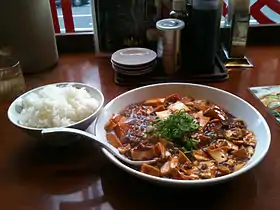 Mapo doufu
Mapo doufu Mala စတိုင် Hot Pot
Mala စတိုင် Hot Pot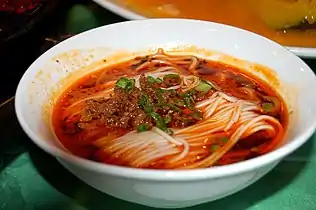 Dandan ခေါက်ဆွဲ
Dandan ခေါက်ဆွဲ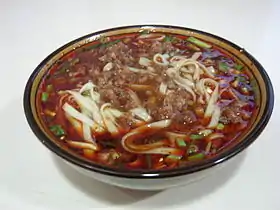 ရောနှောထားသောငံပြာရည်ခေါက်ဆွဲ ( 杂酱面 )
ရောနှောထားသောငံပြာရည်ခေါက်ဆွဲ ( 杂酱面 )
ခရီးသွားလုပ်ငန်း
 Jiuzhaigou
Jiuzhaigou.jpg.webp) Yading
Yading Huanglong ရှုခင်းနှင့်သမိုင်းဝင်စိတ်ဝင်စားမှုAreaရိယာ
Huanglong ရှုခင်းနှင့်သမိုင်းဝင်စိတ်ဝင်စားမှုAreaရိယာ Qincheng တောင်ရှိ ရေတံခွန်များ
Qincheng တောင်ရှိ ရေတံခွန်များ
စီချွမ်ပြည်နယ်နှင့်ချုံကင်းမြူနီစီပယ်ရှိ ယူနက်စကို ကမ္ဘာ့အမွေအနှစ်နေရာများတွင် -
- Dazu Rock Carvings နှင့် Wulong Karst ( ချုံကင်း စည်ပင်သာယာ )
- Huanglong ရှုခင်းနှင့်သမိုင်းဝင်စိတ်ဝင်စားမှုAreaရိယာ
- Jiuzhaigou ချိုင့်ဝှမ်း နှင့်သမိုင်းဝင်စိတ်ဝင်စားမှုAreaရိယာ
- Leshan Giant Buddha ရှုခင်းincludingရိယာအပါအဝင် Emei ရှုခင်းသာMountရိယာ
- Qincheng တောင်တန်း နှင့် Dujiangyan ဆည်မြောင်းစနစ်
- စီချွမ်ကုမ္ပဏီကြီး Panda Sanctuaries
ကိုးကား
- Haw၊ Stephen G (2008)။ A Traveller's History of China။ Interlink Books။ p. 83။
- China General Social Survey (CGSS) 2009, Chinese Spiritual Life Survey (CSLS) 2007. Report by: Xiuhua Wang (2015, p. 15) Archived 25 September 2015 at the Wayback Machine.
- မော်ကွန်းတင်ပြီးမိတ္တူ (in zh-hans) (2011)။ 27 April 2017 တွင် မူရင်းအား မော်ကွန်းတင်ပြီး။ 25 May 2020 တွင် ပြန်စစ်ပြီး။
- Tokyo Sentaku [in Japanese]. 1 June 1999. "Cult Groups Seen Shaking Party Leadership" (FBIS-CHI-1999-0614 1 June 1999/WNC). Cited in: ecoi.net, The Tian Dao (Yi Guan Dao, Yiguandao, Yi Guandao) sect and treatment of believers by the authorities Archived 9 October 2016 at the Wayback Machine.. [CHN32887.E] [ID 171890].
- Min Junqing. The Present Situation and Characteristics of Contemporary Islam in China. JISMOR, 8. 2010 Islam by province, page 29 Archived 27 April 2017 at the Wayback Machine.. Data from: Yang Zongde, Study on Current Muslim Population in China, Jinan Muslim, 2, 2010.
- Some of the data collected by the Chinese General Social Survey (CGSS) of 2009 and by the Chinese Spiritual Life Survey (CSLS) of 2007 have been reported and assembled by Xiuhua Wang (2015)[2] in order to confront the proportion of people identifying with two similar social structures: ① Christian churches, and ② the traditional Chinese religion of the lineage (i. e. people believing and worshipping ancestral deities often organised into lineage "churches" and ancestral shrines). Data for other religions with a significant presence in China (deity cults, Buddhism, Taoism, folk religious sects, Islam, et. al.) were not reported by Wang and come from different sources.
- Based on a 2006 survey of the distribution of Buddhist institutions in China,[3] assuming that the percentage of institutions per capita is consistent with the percentage of Buddhists (which has been proved so by data on other regions), the Buddhist religion would account for between 10% and 20% (≈15%) of the population of Sichuan.
- As of 2010 there are 11,200 Muslims in Sichuan.[5]
